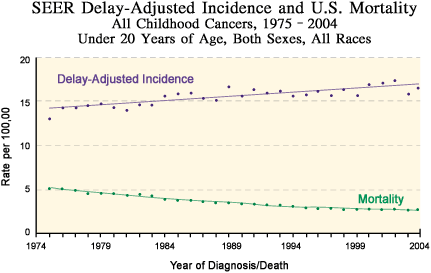 |

Because of the rarity of cancer in children and adolescents, for researchers investigating childhood cancer risks, it's proven difficult to get large enough study populations that can provide reliable, statistically valid conclusions about factors that may only moderately increase cancer risk.
However, through increased collaboration, researchers are retooling their approaches in hopes of getting stronger data on such factors. Their goal is to answer some difficult questions about how a disease like cancer, which is thought to take years or even decades to develop, can take hold in humans within just a few years - or sometimes months - of birth.
"If it's a huge risk, you don't necessarily need enormous numbers to be able to identify the risk factor," explains Dr. Martha S. Linet, chief of the Radiation Epidemiology Branch in NCI's Division of Cancer Epidemiology and Genetics (DCEG). Down syndrome, for example, increases childhood leukemia risk 40-fold. But most childhood leukemia case-control studies, Dr. Linet continues, have identified factors with far smaller risks.
"When these small risks are discovered, it's very difficult to tease apart if they're real, or due to some confounding factors," Dr. Linet says.
The International Childhood Cancer Cohort Consortium is designed to address this problem. Comprising 11 cohorts - none of which was established to study cancer - this international consortium involves more than 70,000 children who are enrolled by their parents before or at birth and, depending on which cohort, will be followed for varying time periods. Each cohort study, while not identically designed, includes detailed questionnaires about potential exposures and the collection of biological samples for molecular analyses.
"Over time," Dr. Linet says, "we're going to be exploring some promising hypotheses that are difficult to study in case-control studies."
Exploration of genetic risks for pediatric cancer has also been limited by small numbers. Such research has mostly been relegated to familial cancers or cancers associated with syndromes such as Li-Fraumeni.

"We've learned a lot from the cancer predisposition syndromes," says Dr. Sharon Savage, an investigator in DCEG's Clinical Genetics Branch. But, because of the rarity of childhood cancers, "We don't yet have a good understanding of how common genetic variants like SNPs (single nucleotide polymorphisms) may affect risk."
Despite the small sample sizes, some headway is being made. In an August 2007 Cancer Epidemiology, Biomarkers & Prevention study, for instance, Dr. Savage and NCI colleagues analyzed blood samples from 104 patients with osteosarcoma, which is most prevalent in adolescent boys, and found a two-fold increased risk associated with SNPs in IGF2R, a critical gene for growth regulation.
But now they need more numbers. And, with the help of the Children's Oncology Group (COG), they will try to replicate the study with a larger sample size, using 500 to 600 tumor samples from osteosarcoma patients enrolled in COG trials.
Although it's still unclear what this line of investigation will ultimately mean for the prevention or treatment of osteosarcoma, Dr. Savage says, "We're hopeful that it can inform osteosarcoma research as well as other research into cancers in which similar pathways play a role."
|